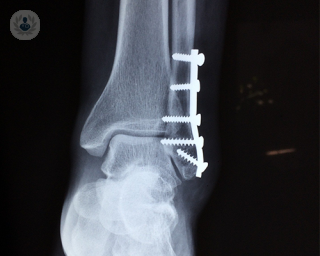Fractured ankle
Mr Thomas Hester - Orthopaedic surgery
Created on: 11-13-2012
Updated on: 10-18-2023
Edited by: Carlota Pano
What is a fractured ankle (broken ankle)?
A fractured ankle is a break in one of the three ankle bones (tibia, fibula and talus). These fractures may be partial (partially cracked bone), complete (perforated in two parts and bone), or may occur on one or both sides of the ankle. The injury may be caused by a fall or trauma.

What causes a broken ankle?
A broken ankle occurs when too much force is placed on the ankle. This can be the result of the following:
- Falling – which results in placing excessive weight on the ankle.
- Heavy impact – from jumping.
- Missteps – when you put your foot down awkwardly when walking, resulting in an ankle twist
- Sports – a lot of high-impact sports, such as rugby and football can place stress on the ankle joint.
What are the symptoms of a broken ankle?
You may experience the following symptoms with a fractured ankle:
- throbbing pain
- pain when moving and that decreases with rest
- swelling
- bruising
- tenderness
- deformity
- difficulty in walking
If the fracture is severe, you may notice that the parts of the fractured bone show through the skin.
How can I tell the difference between a broken or sprained ankle?
The symptoms of an ankle sprain are very similar to a broken ankle. An ankle sprain occurs when you damage the ligaments (the tough, stretchy bands that hold the bones in place) in your ankle. A fractured ankle occurs when at least one of the three bones in your ankle breaks.
Usually, when a broken ankle occurs, you might hear a crack whereas a sprain occurs silently. If the bone is broken, the ankle will look very misshapen. It will be accompanied by numbness or tingling if broken. With a sprain, you usually feel a lot of pain.
How is a broken ankle diagnosed?
Your doctor will do different tests, such as a physical examination to check for swelling and tenderness. They may do an X-ray, musculoskeletal ultrasound, CT scan, or MRI scan to see the location, type and severity of the break. An MRI scan can help the doctor find the fractures that the X-ray does not pick up.
How is a broken ankle treated?
A broken ankle can take between six weeks to a few months to fully heal to the point where you are back to your regular routine. As the ankle heals, you will be able to incorporate an exercise program that includes stretching, range of motion, strengthening and balancing exercises.
In some cases, the injury may require surgery, including the use of metal pins, screws or plates to hold the bones in place while the fracture heals. There are several different types of surgery that are used to treat fractured ankles.
If the ankle fracture is treated without surgery, it is likely that the patient must wear a cast for at least six weeks. Most people need at least a period of between six and ten weeks to fully recover from a broken ankle.

Are there any risks to ankle surgery?
There are a few risks or possible complications associated with ankle surgery, as with any surgical procedure. These include:
- thrombosis (blood clots)
- bleeding
- nerve damage, or damage to the blood vessels
- negative reaction to anaesthesia
- stiffness of the ankle joint, or weakness
What should I avoid when recovering from a broken ankle?
In the weeks following ankle surgery, you should not partake in any heavy exercise, and try not to put a lot of weight on the ankle. You can also ease some of the pain and swelling by applying ice, compression and massaging around the ankle. You can ice the ankle for up to 20 minutes each time.
Will my ankle ever be fully healed?
This depends on the severity of the fracture or damage done to the bone. If it was a low-to-medium grade fracture, then your ankle should be very similar to how it was before your injury. The more severe the injury, the more likely that you may experience some ankle problems moving forward.
What type of specialist treats a fractured ankle?
An orthopaedic surgeon will normally treat a fractured ankle.














